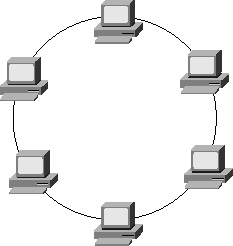Foundations of Networking
Open Systems Interconnection (OSI) ProtocolsThe OSI protocols are a suite of protocols that encompass all seven layers of the OSI reference model. They are part of an international program to develop data networking protocols that are based upon the OSI model as a reference. It is important to mention these briefly, but they are truly beyond the scope of this book. If you desire to learn more about them, read the following books to achieve a solid understanding:
Intranet TopologiesThe preceding sections discussed the evolution of networks into today s intranets. The sections on the OSI reference model showed the essential means of how data is transported between the various layers running on all intranet devices. This section addresses the media operating on your Internet. Both local- and wide-area topologies will be discussed in the following sections. Local Area Networks (LANs)LANs connect workstations, servers, legacy systems, and miscellaneous network-accessible equipment, which are in turn interconnected to form your network. The most common types of LANs include the following:
Ethernet Ethernet technology adheres to IEEE Standard 802.3. The requirements of the standard are that the LAN supports 10Mbps over coaxial cabling. Ethernet was originally developed by Xerox in the early 1970s to serve networks with sporadic, and occasionally heavy, network traffic. Ethernet Version 2.0 was jointly developed by Digital Equipment Corp., Intel Corp., and Xerox Corp. It is compatible with IEEE 802.3 Standards. Ethernet technology is commonly referred to as Carrier Sense Multiple Access with Carrier Detect (CSMA/CD). What this means is that the Ethernet device will operate as long as it senses a carrier (or a signal) on the physical wire. When an Ethernet device wants to send a packet out of its interface, it will sense for traffic on the wire. If no other traffic is detected, the device will put its data onto the wire and send it to all other devices that are physically connected to the LAN segment. From time to time, two devices will send data out at the same time. When this occurs, the two packets that are on the wire have what is known as a collision. Built into Ethernet is a retransmission timer known as a back-off algorithm. If an Ethernet device detects a collision, it will perform a random calculation based upon the back-off algorithm before it will send another packet (or resend the original) to prevent further collisions on the wire. Because each device that detects the original collision performs this random calculation, each derives a different value for the resend timer; therefore, the possibility of future collisions on the wire are reduced. Figure 1-8 illustrates a typical Ethernet LAN.
If you need further information on this subject, a very good reference can be found at: http://wwwhost.ots.utexas.edu/ethernet/ethernet-home.html. Token Ring Token Ring is defined in IEEE Standard 802.5, developed by IBM in the 1970s. It is known as Token Ring because of its built-in token passing capability. Token Ring runs at speeds of 4 and 16Mbps. It also passes a small packet, known as a token, around the network. Whenever a workstation desires to send information out on the wire (ring), it must first have possession of this token. After the workstation has the token, it alters one bit (frame copied) within it and retransmits it back onto the network. It is retransmitted as a start of frame sequence and is immediately followed with the information it wants to transmit. This information will circle the ring until the destination is reached, at which time it retrieves the information off the wire. The start of frame packet is then released to flow back to the sending workstation, at which time it changes it back to the original format and releases the token back onto to the wire. Then, the process begins again. Token Ring technology has two fault management techniques:
Whenever a serious ring problem is detected, a beacon frame is sent out. This beacon frame commands stations to reconfigure to repair the failure. Figure 1-9 illustrates a typical Token Ring LAN.
|
EAN: 2147483647
Pages: 200

